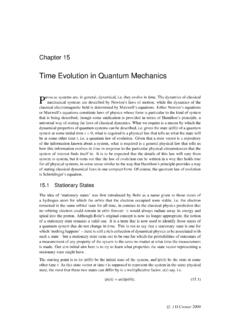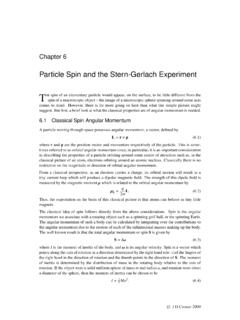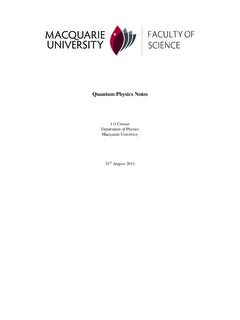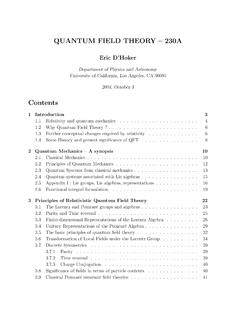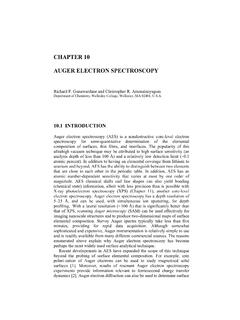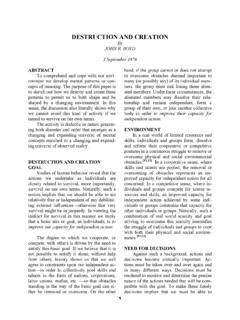Transcription of The Wave Function - Macquarie University
1 Chapter 3 The Wave FunctionOnthe basis of the assumption that the de Broglie relations give the frequency and wavelengthof some kind of wave to be associated with a particle, plus the assumption that it makessense to add together waves of different frequencies, it is possible to learn a considerable amountabout these waves without actually knowing beforehand what they represent. But studying differ-ent examples does provide some insight into what the ultimate interpretation is, the so-called Borninterpretation, which is that these waves are probability waves in the sense that the amplitudesquared of the waves gives the probability of observing (or detecting, or finding a number ofdifferent terms are used) the particle in some region in space.
2 Hand-in-hand with this interpreta-tion is the heisenberg uncertainty principle which, historically, preceded the formulation of theprobability interpretation. From this principle, it is possible to obtain a number of fundamentalresults even before the full machinery of wave mechanics is in this Chapter, some of the consequences of de Broglie s hypothesis of associating waves withparticles are explored, leading to the concept of the wave Function , and its probability Harmonic Wave FunctionOn the basis of de Broglie s hypothesis, there is associated with a particle of energyEand mo-mentump, a wave of frequencyfand wavelength given by the de Broglie relations Eq. ( ).It is more usual to work in terms of the angular frequency =2 fand wave numberk=2 / sothat the de Broglie relations become =E/!
3 K=p/!.( )With this in mind, and making use of what we already know about what the mathematical form isfor a wave, we are in a position to make a reasonable guess at a mathematical expression for thewave associated with the particle. The possibilities include (in one dimension) (x,t)=Asin(kx t),Acos(kx t),Aei(kx t),..( )At this stage, we have no idea what the quantity (x,t) represents physically. It is given the namethewave Function , and in this particular case we will use the term harmonic wave Function todescribe any trigonometric wave Function of the kind listed above. As we will see later, in generalit can take much more complicated forms than a simple single frequency wave, and is almostalways a complex valued Function .
4 In fact, it turns out that the third possibility listed above isthe appropriate wave Function to associate with a free particle, but for the present we will workwith real wave functions, if only because it gives us the possibility of visualizing their form whilediscussing their J D Cresser 2009 Chapter 3 The Wave Function15In order to gain an understanding of what a wave Function might represent, we will turn thingsaround briefly and look at what we can learn about a particle if we know what its wave Function are implicitly bypassing here any consideration of whether we can understand a wave functionas being a physical wave in the same way that a sound wave, a water wave, or a light wave arephysical waves, waves made of some kind of physical stuff.
5 Instead, we are going to look ona wave Function as something that gives us information on the particle it is associated with. To thisend, we will suppose that the particle has a wave Function given by (x,t)=Acos(kx t). Then,given that the wave has angular frequency and wave numberk, it is straightforward to calculatethe wave velocity, that is, the phase velocityvpof the wave, which is just the velocity of the wavecrests. This phase velocity is given byvp= k=! !k=Ep=12mv2mv=12v.( )Thus, given the frequency and wave number of a wave Function , we can determine the speed ofthe particle from the phase velocity of its wave Function ,v=2vp. We could also try to learnfrom the wave Function the position of the particle.
6 However, the wave Function above tells usnothing about where the particle is to be found in space. We can make this statement because thiswave Function is more or less the same everywhere. For sure, the wave Function is notexactlythesame everywhere, but any feature that we might decide as being an indicator of the position ofthe particle, say where the wave Function is a maximum, or zero, will not do: the wave functionis periodic, so any feature, such as where the wave Function vanishes, reoccurs an infinite numberof times, and there is no way to distinguish any one of these repetitions from any other, see Fig.( ). (x,t)xFigure :A wave Function of constant amplitude and wavelength. The wave is the same everywhere andso there is no distinguishing feature that could indicate one possible position of the particle from any , this particular wave Function gives no information on the whereabouts of the particle withwhich it is associated.
7 So from a harmonic wave Function it is possible to learn how fast a particleis moving, but not what the position is of the PacketsFrom what was said above, a wave Function constant throughout all space cannot give informationon the position of the particle. This suggests that a wave Function that did not have the sameamplitude throughout all space might be a candidate for a giving such information. In fact, sincewhat we mean by a particle is a physical object that is confined to a highly localized region inspace, ideally a point, it would be intuitively appealing to be able to devise a wave Function thatis zero or nearly so everywhere in space except for one localized region. It is in fact possible toconstruct, from the harmonic wave functions, a wave Function which has this property.
8 To showhow this is done, we first consider what happens if we combine together two harmonic waveswhose wave numbers are very close together. The result is well-known: a beat note is produced, periodically in space the waves add together in phase to produce a local maximum, whilec J D Cresser 2009 Chapter 3 The Wave Function16midway in between the waves will be totally out of phase and hence will destructively is illustrated in Fig. (a) where we have added together two waves cos(5x)+cos( ).(a)(b)(c)(d)Figure :(a) Beat notes produced by adding together two cos waves: cos(5x)+cos( ).(b) Combining five cos waves: cos( )+cos( )+cos(5x)+cos( )+cos( ).(c) Combining seven cos waves: cos( )+cos( )+cos( )+cos(5x)+cos( )+cos( )+cos( ).
9 (d) An integral over a continuous range of wave numbers produces a single wave suppose we add five such waves together, as in Fig. (b). The result is that some beatsturn out to be much stronger than the others. If we repeat this process by adding seven wavestogether, but now make them closer in wave number, we get Fig. (c), we find that most of thebeat notes tend to become very small, with the strong beat notes occurring increasingly far , what we are doing here is taking a limit of a sum, and turning this sum into anintegral. In the limit, we find that there is only one beat note in effect, all the other beat notesbecome infinitely far away. This single isolated beat note is usually referred to as a wave need to look at this in a little more mathematical detail, so suppose we add together a largenumber of harmonic waves with wave numbersk1,k2,k3.
10 All lying in the range:k k!kn!k+ k( )around a valuek, (x,t)=A(k1) cos(k1x 1t)+A(k2) cos(k2x 2t)+..= nA(kn) cos(knx nt)( )whereA(k) is a Function peaked about the valuekwith a full width at half maximum of 2 k. (Thereis no significance to be attached to the use of cos functions here the idea is simply to illustrate ac J D Cresser 2009 Chapter 3 The Wave Function17point. We could equally well have used a sin Function or indeed a complex exponential.) What isfound is that in the limit in which the sum becomes an integral: (x,t)= + A(k) cos(kx t)dk( )all the waves interfere constructively to produce only a single beat note as illustrated in Fig. (d)above1. The wave Function or wave packet so constructed is found to have essentially zero ampli-tude everywhere except for asinglelocalized region in space, over a region of width 2 x, thewave Function (x,t) in this case takes the form of a single wave packet, see Fig.



